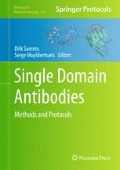Abstract
Fluorescent proteins are widely used to study protein localization and protein dynamics in living cells. Additional information on peptide binding, DNA binding, enzymatic activity, and complex formation can be obtained with various methods including chromatin immunoprecipitation (ChIP) and affinity purification. Here we describe two specific GFP- and RFP binding proteins based on antibody fragments derived from llama single domain antibodies. The binding proteins can be produced in bacteria and coupled to monovalent matrixes generating so-called Nanotraps. Both Nanotraps allow a fast and efficient (one-step) isolation of fluorescent fusion proteins and their interacting factors for biochemical analyses including mass spectroscopy and enzyme activity measurements. Here we provide protocols for precipitation of fluorescent fusion proteins from crude cell extracts to identify and map protein–protein interactions as well as specific histone tail peptide binding in an easy and reliable manner.
Access this chapter
Tax calculation will be finalised at checkout
Purchases are for personal use only
References
Baird GS, Zacharias DA, Tsien RY (2000) Biochemistry, mutagenesis, and oligomerization of DsRed, a red fluorescent protein from coral. Proc Natl Acad Sci U S A 97:11984–11989
Campbell RE, Tour O, Palmer AE, Steinbach PA, Baird GS, Zacharias DA, Tsien RY (2002) A monomeric red fluorescent protein. Proc Natl Acad Sci U S A 99:7877–7882
Cristea IM, Williams R, Chait BT, Rout MP (2005) Fluorescent proteins as proteomic probes. Mol Cell Proteomics 4:1933–1941
Rottach A, Kremmer E, Nowak D, Leonhardt H, Cardoso MC (2008) Generation and characterization of a rat monoclonal antibody specific for multiple red fluorescent proteins. Hybridoma (Larchmt) 27:337–343
Rothbauer U, Zolghadr K, Muyldermans S, Schepers A, Cardoso MC, Leonhardt H (2008) A versatile nanotrap for biochemical and functional studies with fluorescent fusion proteins. Mol Cell Proteomics 7:282–289
Trinkle-Mulcahy L, Boulon S, Lam YW, Urcia R, Boisvert FM, Vandermoere F, Morrice NA, Swift S, Rothbauer U, Leonhardt H, Lamond A (2008) Identifying specific protein interaction partners using quantitative mass spectrometry and bead proteomes. J Cell Biol 183:223–239
Agarwal N, Hardt T, Brero A, Nowak D, Rothbauer U, Becker A, Leonhardt H, Cardoso MC (2007) MeCP2 interacts with HP1 and modulates its heterochromatin association during myogenic differentiation. Nucleic Acids Res 35:5402–5408
Schermelleh L, Haemmer A, Spada F, Rosing N, Meilinger D, Rothbauer U, Cristina Cardoso M, Leonhardt H (2007) Dynamics of Dnmt1 interaction with the replication machinery and its role in postreplicative maintenance of DNA methylation. Nucleic Acids Res 35:4301–4312
Frauer C, Leonhardt H (2009) A versatile non-radioactive assay for DNA methyltransferase activity and DNA binding. Nucleic Acids Res 37:e22
Bergbauer M, Kalla M, Schmeinck A, Gobel C, Rothbauer U, Eck S, Benet-Pages A, Strom TM, Hammerschmidt W (2010) CpG-methylation regulates a class of Epstein-Barr virus promoters. PLoS Pathog 6:e1001114
Munoz IM, Hain K, Declais AC, Gardiner M, Toh GW, Sanchez-Pulido L, Heuckmann JM, Toth R, Macartney T, Eppink B, Kanaar R, Ponting CP, Lilley DM, Rouse J (2009) Coordination of structure-specific nucleases by human SLX4/BTBD12 is required for DNA repair. Mol Cell 35:116–127
Rottach A, Frauer C, Pichler G, Bonapace IM, Spada F, Leonhardt H (2010) The multi-domain protein Np95 connects DNA methylation and histone modification. Nucleic Acids Res 38:1796–1804
Acknowledgements
This work was supported by the GO-Bio Program of the BMBF (Federal Ministry of Science, Germany) and the Deutsche Forschungsgemeinschaft (SFB 646).
Author information
Authors and Affiliations
Corresponding author
Editor information
Editors and Affiliations
Rights and permissions
Copyright information
© 2012 Springer Science+Business Media, LLC
About this protocol
Cite this protocol
Pichler, G., Leonhardt, H., Rothbauer, U. (2012). Fluorescent Protein Specific Nanotraps to Study Protein–Protein Interactions and Histone-Tail Peptide Binding. In: Saerens, D., Muyldermans, S. (eds) Single Domain Antibodies. Methods in Molecular Biology, vol 911. Humana Press, Totowa, NJ. https://doi.org/10.1007/978-1-61779-968-6_29
Download citation
DOI: https://doi.org/10.1007/978-1-61779-968-6_29
Published:
Publisher Name: Humana Press, Totowa, NJ
Print ISBN: 978-1-61779-967-9
Online ISBN: 978-1-61779-968-6
eBook Packages: Springer Protocols

